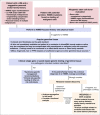How I diagnose and manage individuals at risk for inherited myeloid malignancies
- PMID: 27471235
- PMCID: PMC5813725
- DOI: 10.1182/blood-2016-05-670240
How I diagnose and manage individuals at risk for inherited myeloid malignancies
Abstract
Although inherited hematopoietic malignancies have been reported clinically since the early twentieth century, the molecular basis for these diseases has only recently begun to be elucidated. Growing utilization of next-generation sequencing technologies has facilitated the rapid discovery of an increasing number of recognizable heritable hematopoietic malignancy syndromes while also deepening the field's understanding of the molecular mechanisms that underlie these syndromes. Because individuals with inherited hematopoietic malignancies continue to be underdiagnosed and are increasingly likely to be encountered in clinical practice, clinicians need to have a high index of suspicion and be aware of the described syndromes. Here, we present the methods we use to identify, test, and manage individuals and families suspected of having a hereditary myeloid malignancy syndrome. Finally, we address the areas of ongoing research in the field and encourage clinicians and researchers to contribute and collaborate.
© 2016 by The American Society of Hematology.
Figures



Similar articles
-
Evaluation of Patients and Families With Concern for Predispositions to Hematologic Malignancies Within the Hereditary Hematologic Malignancy Clinic (HHMC).Clin Lymphoma Myeloma Leuk. 2016 Jul;16(7):417-428.e2. doi: 10.1016/j.clml.2016.04.001. Epub 2016 Apr 27. Clin Lymphoma Myeloma Leuk. 2016. PMID: 27210295 Free PMC article.
-
Recognition of familial myeloid neoplasia in adults.Semin Hematol. 2017 Apr;54(2):60-68. doi: 10.1053/j.seminhematol.2016.11.003. Epub 2017 Apr 18. Semin Hematol. 2017. PMID: 28637618 Review.
-
Approach Toward Germline Predisposition Syndromes in Patients with Hematologic Malignancies.Curr Hematol Malig Rep. 2022 Dec;17(6):275-285. doi: 10.1007/s11899-022-00684-2. Epub 2022 Oct 24. Curr Hematol Malig Rep. 2022. PMID: 36279069 Review.
-
Germline Predisposition in Hematologic Malignancies: Testing, Management, and Implications.Am Soc Clin Oncol Educ Book. 2024 Jun;44(3):e432218. doi: 10.1200/EDBK_432218. Am Soc Clin Oncol Educ Book. 2024. PMID: 38768412 Review.
-
Inherited predisposition to haematopoietic malignancies: overcoming barriers and exploring opportunities.Br J Haematol. 2021 Aug;194(4):663-676. doi: 10.1111/bjh.17247. Epub 2020 Dec 5. Br J Haematol. 2021. PMID: 33615436 Review.
Cited by
-
Genetic Characteristics of Patients with Young-Onset Myelodysplastic Neoplasms.J Clin Med. 2023 Dec 13;12(24):7651. doi: 10.3390/jcm12247651. J Clin Med. 2023. PMID: 38137719 Free PMC article.
-
GATA2 mutation in long stand Mycobacterium kansasii infection, myelodysplasia and MonoMAC syndrome: a case-report.BMC Med Genet. 2019 Apr 29;20(1):64. doi: 10.1186/s12881-019-0799-6. BMC Med Genet. 2019. PMID: 31035956 Free PMC article.
-
Germline ETV6 mutations and predisposition to hematological malignancies.Int J Hematol. 2017 Aug;106(2):189-195. doi: 10.1007/s12185-017-2259-4. Epub 2017 May 29. Int J Hematol. 2017. PMID: 28555414 Review.
-
Allogeneic hematopoietic stem cell transplant outcomes in adults with inherited myeloid malignancies.Blood Adv. 2023 Feb 28;7(4):549-554. doi: 10.1182/bloodadvances.2022008172. Blood Adv. 2023. PMID: 36001442 Free PMC article.
-
Implementation of and Systems-Level Barriers to Guideline-Driven Germline Genetic Evaluation in the Care of Patients With Myelodysplastic Syndrome and Acute Myeloid Leukemia.JCO Precis Oncol. 2024 Jun;8:e2300518. doi: 10.1200/PO.23.00518. JCO Precis Oncol. 2024. PMID: 38848520
References
-
- Gunz FW, Gunz JP, Veale AM, Chapman CJ, Houston IB. Familial leukaemia: a study of 909 families. Scand J Haematol. 1975;15(2):117–131. - PubMed
-
- Luddy RE, Champion LA, Schwartz AD. A fatal myeloproliferative syndrome in a family with thrombocytopenia and platelet dysfunction. Cancer. 1978;41(5):1959–1963. - PubMed
-
- Fanconi anemia: guidelines for diagnosis and management. 4th ed. Eugene, OR: Fanconi Anemia Research Fund, Inc; 2014. http://fanconi.org/index.php/publications/guidelines_for_diagnosis_and_m.... Accessed 14 July 2016.
-
- Nagy R, Sweet K, Eng C. Highly penetrant hereditary cancer syndromes. Oncogene. 2004;23(38):6445–6470. - PubMed
MeSH terms
Grants and funding
LinkOut - more resources
Full Text Sources
Other Literature Sources

